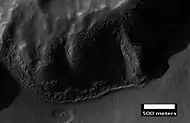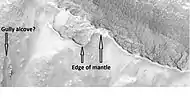纬度相关覆盖层
大部分火星表面都披覆了一层厚厚的富冰覆盖层,该覆盖层是过去多次从天空飘落的冰核尘埃所组成[1] [2] [3]。在部分地区可看到覆盖层中的一些分层[4]。


 前一幅法厄同区覆盖层分层图像的放大,可看到4到5层分层。
前一幅法厄同区覆盖层分层图像的放大,可看到4到5层分层。 HiWish计划下高分辨率成像科学设备显示的塞壬高地披覆及未披覆覆盖层的地表。
HiWish计划下高分辨率成像科学设备显示的塞壬高地披覆及未披覆覆盖层的地表。 HiWish计划下高分辨率成像科学设备显示的埃里达尼亚区覆盖层。
HiWish计划下高分辨率成像科学设备显示的埃里达尼亚区覆盖层。 HiWish计划下高分辨率成像科学设备显示的埃里达尼亚区披覆及未披覆气候变化时从天空落下的覆盖层地表近景。
HiWish计划下高分辨率成像科学设备显示的埃里达尼亚区披覆及未披覆气候变化时从天空落下的覆盖层地表近景。 HiWish计划下高分辨率成像科学设备拍摄的刻布壬尼亚区覆盖层近景,覆盖层可能由过去气候条件下从天空降落的冰及尘埃组成。
HiWish计划下高分辨率成像科学设备拍摄的刻布壬尼亚区覆盖层近景,覆盖层可能由过去气候条件下从天空降落的冰及尘埃组成。 HiWish计划下高分辨率成像科学设备显示的希腊区含分层的平坦覆盖层。
HiWish计划下高分辨率成像科学设备显示的希腊区含分层的平坦覆盖层。 HiWish计划下高分辨率成像科学设备显示的伊斯墨诺斯湖区覆盖层近景,箭头指示陨石坑边缘突出的覆盖层厚度。
HiWish计划下高分辨率成像科学设备显示的伊斯墨诺斯湖区覆盖层近景,箭头指示陨石坑边缘突出的覆盖层厚度。 HiWish计划下高分辨率成像科学设备显示了伊斯墨诺斯湖区覆盖层厚度的近景。
HiWish计划下高分辨率成像科学设备显示了伊斯墨诺斯湖区覆盖层厚度的近景。


 HiWish计划下高分辨率成像科学设备显示的覆盖层近景图。
HiWish计划下高分辨率成像科学设备显示的覆盖层近景图。 HiWish计划下高分辨率成像科学设备显示的覆盖层近景图。
HiWish计划下高分辨率成像科学设备显示的覆盖层近景图。
从天空降落的冰核尘埃,很好地证明了这层覆盖层富含水冰。许多表面常见的多边形形状也表明土壤中富含冰。2001火星奥德赛号发现了高含量的氢(可能来自水)[5][6] [7] [8] [9]。从轨道上进行的热辐射测量表明了冰的存在[10] [11];凤凰号火星探测器降落在一片多边形区域中,它发现了水冰,并进行了直接观测[12][13],事实上,它的着陆火箭暴露了纯冰。理论预测在几厘米厚的土壤下会发现冰。该覆盖层被称为“纬度相关覆盖层”,因为它的出现与纬度有关。正是这层覆盖层后来的破裂,才形成了多边形地面。这种富含水冰地面的破裂是根据物理作用所预测的[14][15] [16] [17][18] [19][20]。另一种表面被称为“脑纹地形”,因为它看起来像人脑的表面。当两种区域同时出现时,脑纹地形高度较多边形地面更低。
 HiWish计划下高分辨率成像科学设备拍摄的线状谷底沉积,显示了下一幅图像来源的背景照片。
HiWish计划下高分辨率成像科学设备拍摄的线状谷底沉积,显示了下一幅图像来源的背景照片。 HiWish计划下高分辨率成像科学设备显示的细胞开放型和细胞封闭型脑纹地形。
HiWish计划下高分辨率成像科学设备显示的细胞开放型和细胞封闭型脑纹地形。 HiWish计划下高分辨率成像科学设备显示,脑纹地形形成于较厚的地层,箭头指示较厚的单元分裂成小细胞。
HiWish计划下高分辨率成像科学设备显示,脑纹地形形成于较厚的地层,箭头指示较厚的单元分裂成小细胞。
尽管相邻下层的脑纹地形参差不齐,但从顶层开始,多边形层相当平整。据信,含多边形的覆盖层深度需达10-20米,才能形成平整表面。在所有的冰消失之前,覆盖层会持续很长一段时间,因为顶部会形成一层保护性的滞留沉积物[21] [22] [23]。覆盖层中含有冰和尘埃。当一定数量的冰升华后,尘埃停留在顶部,形成滞留沉积层[24] [25] [26] [27]。 根据多边形地面的总面积计算,估计覆盖层中锁住的总水量约有10米深,这一体积相当于在整个星球覆盖了一层2.5米深的水。但相比之下,地球北极和南极冰盖融化的水则可覆盖整个星球30米深[28]。
覆盖层形成于火星气候与现在不同的时期[29] [30] [31],火星自转轴的倾斜或倾角变化很大[32] [33] [34],而地球的倾斜变化则很小,因为我们相当大的月球稳定了地球。火星只有两颗非常小卫星,它们没有足够的引力来稳定火星的倾斜。当火星倾斜度超过40度(今天是25度)左右时,冰就会沉积在某些纬度带上,而这些纬度带现今存在着大量的覆盖层 [35] [36]。
另请查看
- 火星气候
参考文献
- Hecht, M. 2002. Metastability of water on Mars. Icarus 156, 373–386
- Mustard, J., et al. 2001. Evidence for recent climate change on Mars from the identification of youthful near-surface ground ice. Nature 412 (6845), 411–414.
- Pollack, J., D. Colburn, F. Flaser, R. Kahn, C. Carson, and D. Pidek. 1979. Properties and effects of dust suspended in the martian atmosphere. J. Geophys. Res. 84, 2929-2945.
- . [2021-08-11]. (原始内容存档于2017-09-02).
- Boynton, W., and 24 colleagues. 2002. Distribution of hydrogen in the nearsurface of Mars: Evidence for sub-surface ice deposits. Science 297, 81–85
- Kuzmin, R, et al. 2004. Regions of potential existence of free water (ice) in the near-surface martian ground: Results from the Mars Odyssey High-Energy Neutron Detector (HEND). Solar System Research 38 (1), 1–11.
- Mitrofanov, I. et al. 2007a. Burial depth of water ice in Mars permafrost subsurface. In: LPSC 38, Abstract #3108. Houston, TX.
- Mitrofanov, I., and 11 colleagues. 2007b. Water ice permafrost on Mars: Layering structure and subsurface distribution according to HEND/Odyssey and MOLA/ MGS data. Geophys. Res. Lett. 34 (18). doi:10.1029/2007GL030030.
- Mangold, N., et al. 2004. Spatial relationships between patterned ground and ground ice detected by the neutron spectrometer on Mars. J. Geophys. Res. 109 (E8). doi:10.1029/ 2004JE002235.
- Feldman, W., and 12 colleagues. 2002. Global distribution of neutrons from Mars:Results from Mars Odyssey. Science 297, 75–78.
- Feldman, W., et al. 2008.North to south asymmetries in the water-equivalent hydrogen distribution at high latitudes on Mars. J. Geophys. Res. 113. doi:10.1029/2007JE003020.
- Bright Chunks at Phoenix Lander's Mars Site Must Have Been Ice (页面存档备份,存于) – Official NASA press release (19.06.2008)
- . Nasa.gov. 2008-06-20 [2012-07-13]. (原始内容存档于2008-07-01).
- Mutch, T.A., and 24 colleagues, 1976. The surface of Mars: The view from the Viking2 lander. Science 194 (4271), 1277–1283.
- Mutch, T., et al. 1977. The geology of the Viking Lander 2 site. J. Geophys. Res. 82, 4452–4467.
- Levy, J., et al. 2009. Thermal contraction crack polygons on Mars: Classification, distribution, and climate implications from HiRISE observations. J. Geophys. Res. 114. doi:10.1029/2008JE003273.
- Washburn, A. 1973. Periglacial Processes and Environments. St. Martin’s Press,New York, pp. 1–2, 100–147.
- Mellon, M. 1997. Small-scale polygonal features on Mars: Seasonal thermal contractioncracks in permafrost. J. Geophys. Res. 102, 25,617-625,628.
- Mangold, N. 2005. High latitude patterned grounds on Mars: Classification, distribution and climatic control. Icarus 174, 336–359.
- Marchant, D., J. Head. 2007. Antarctic dry valleys: Microclimate zonation, variable geomorphic processes, and implications for assessing climate change on Mars. Icarus 192, 187–222
- Marchant, D., et al. 2002. Formation of patterned ground and sublimation till over Miocene glacier ice in Beacon valley, southern Victoria land, Antarctica. Geol. Soc. Am. Bull. 114, 718–730.
- Mellon, M., B. Jakosky. 1995. The distribution and behavior of Martian ground ice during past and present epochs. J. Geophys. Res. 100, 11781–11799.
- Schorghofer, N., 2007. Dynamics of ice ages on Mars. Nature 449, 192–194.
- Madeleine, J., F. Forget, J. Head, B. Levrard, F. Montmessin. 2007. Exploring the northern mid-latitude glaciation with a general circulation model. In: Seventh International Conference on Mars. Abstract 3096.
- Schorghofer, N., O. Aharonson. 2005. Stability and exchange of subsurface ice on Mars. J. Geophys. Res. 110 (E05). doi:10.1029/2004JE002350.
- Schorghofer, N., 2007. Dynamics of ice ages on Mars. Nature 449 (7159), 192–194
- Head, J., J. Mustard, M. Kreslavsky, R. Milliken, D. Marchant. 2003. Recent ice ages on Mars. Nature 426 (6968), 797–802.
- Levy, J. et al. 2010. Thermal contraction crack polygons on Mars: A synthesis from HiRISE, Phoenix, and terrestrial analog studies. Icarus: 206, 229-252.
- Mustard, J., et al. 2001. Evidence for recent climate change on Mars from the identification of youthful near-surface ground ice. Nature 412 (6845), 411–414.
- Kreslavsky, M.A., Head, J.W., 2002. High-latitude Recent Surface Mantle on Mars: New Results from MOLA and MOC. European Geophysical Society XXVII, Nice.
- Head, J.W., Mustard, J.F., Kreslavsky, M.A., Milliken, R.E., Marchant, D.R., 2003.Recent ice ages on Mars. Nature 426 (6968), 797–802.
- name= Touma J. and J. Wisdom. 1993. The Chaotic Obliquity of Mars. Science 259, 1294-1297.
- Laskar, J., A. Correia, M. Gastineau, F. Joutel, B. Levrard, and P. Robutel. 2004. Long term evolution and chaotic diffusion of the insolation quantities of Mars. Icarus 170, 343-364.
- Levy, J., J. Head, D. Marchant, D. Kowalewski. 2008. Identification of sublimation-type thermal contraction crack polygons at the proposed NASA Phoenix landing site: Implications for substrate properties and climate-driven morphological evolution. Geophys. Res. Lett. 35. doi:10.1029/2007GL032813.
- Kreslavsky, M., J. Head, J. 2002. Mars: Nature and evolution of young, latitude-dependent water-ice-rich mantle. Geophys. Res. Lett. 29, doi:10.1029/ 2002GL015392.
- Kreslavsky, M., J. Head. 2006. Modification of impact craters in the northern plains of Mars: Implications for the Amazonian climate history. Meteorit. Planet. Sci. 41, 1633–1646.